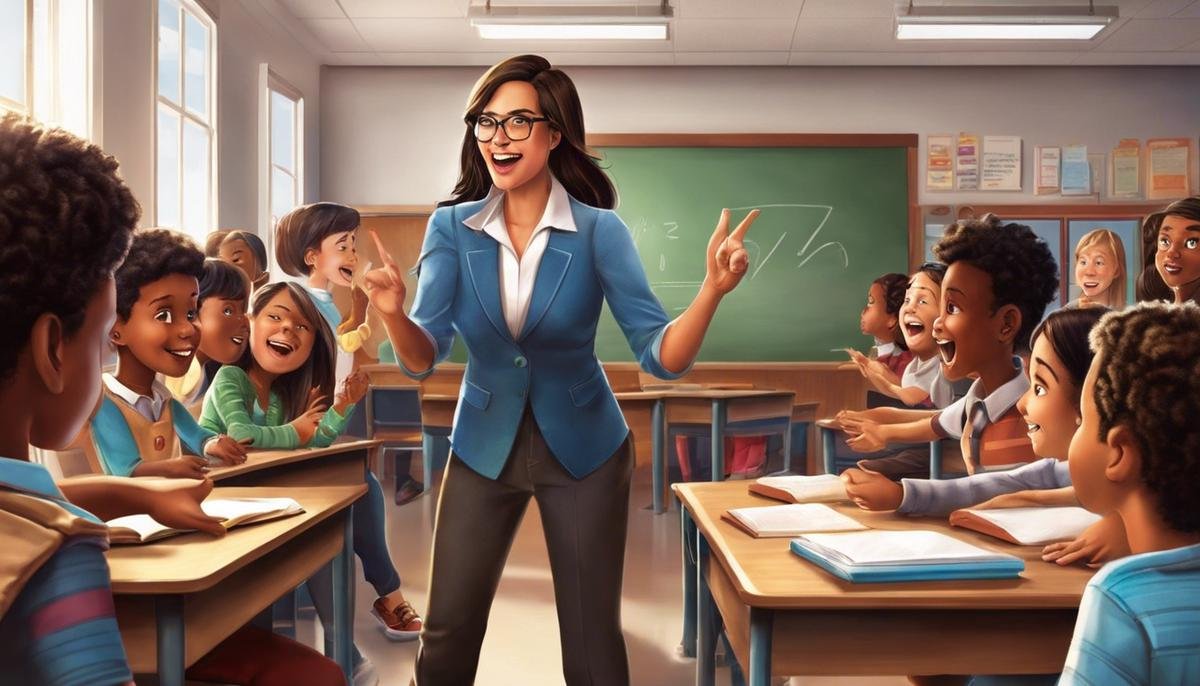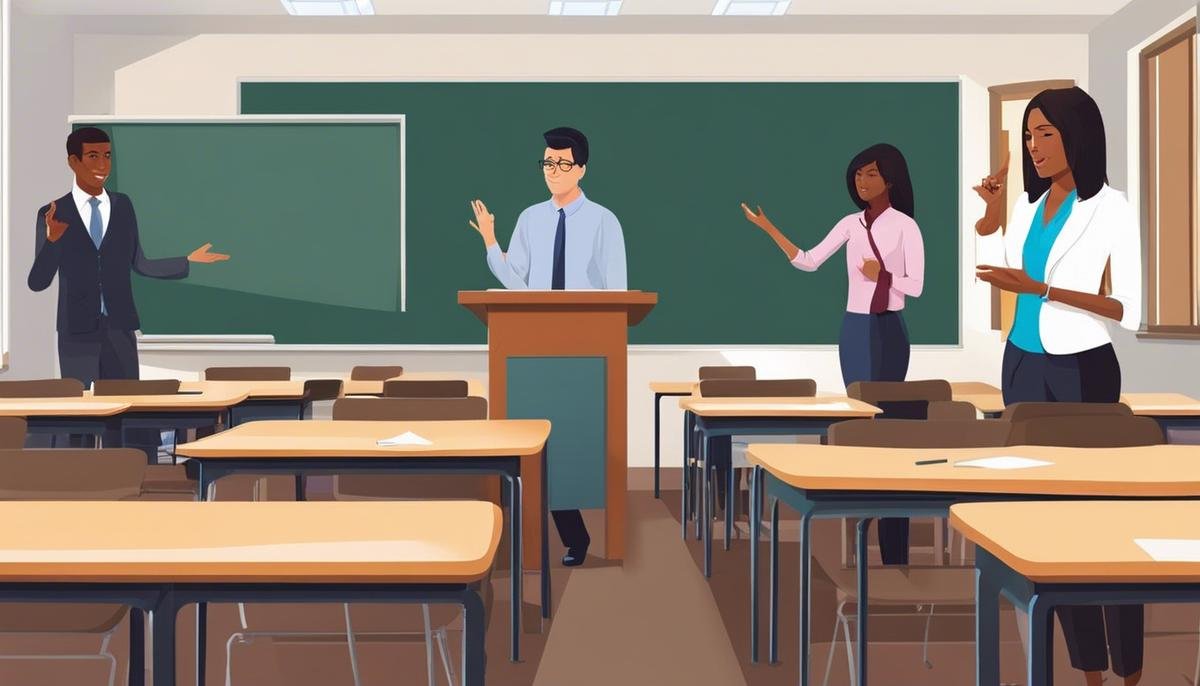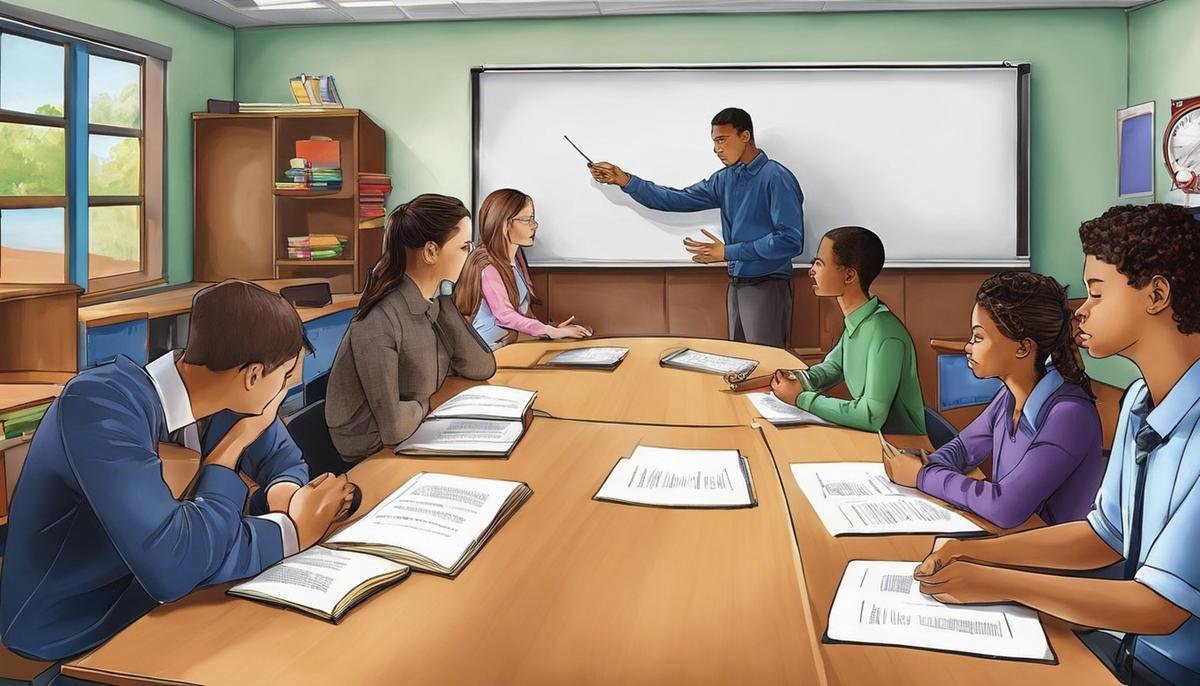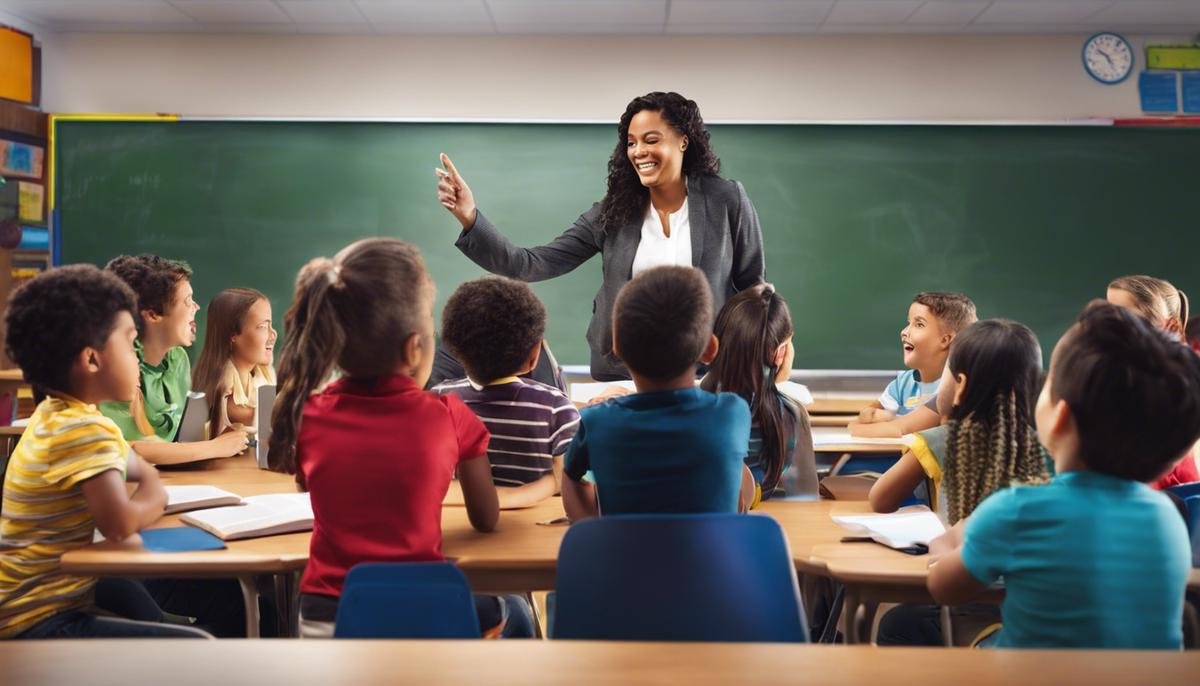
Human communication extends far beyond the spoken word, with countless nuances embedded in gestures, facial expressions, and postures that collectively speak volumes. In the realm of education, these nonverbal signals play a pivotal role, deeply influencing classroom dynamics and the effectiveness of teaching and learning. Through the exploration of body language, educators can unlock new dimensions of engagement, making them key players in the intricate dance of knowledge transfer. As we delve into the silent yet expressive world of nonverbal cues, we uncover the subtle yet powerful means by which teachers and learners connect and resonate with the subject matter at hand.
The Role of Body Language in Classroom Learning
Unlocking Classroom Potential: The Powerful Impact of a Teacher’s Body Language on Student Learning
Hey there, fellow parents and educators! As we navigate through the twists and turns of raising our little ones and nurturing their education, it’s amazing to discover the little things that make big differences. Today, let’s chat about something we all see but may not always consider: the impact of a teacher’s body language on student learning.
Now, whether a teacher stands tall or slumps, keeps arms open wide or crossed tight, each gesture speaks volumes to the kids in class. Believe it or not, the way teachers carry themselves goes beyond mere actions; it’s a form of communication that can set the tone for the learning environment.
Imagine this: a teacher greets their class with a bright smile, open posture, and warm eye contact. This non-verbal “hello” can work wonders. It’s like rolling out a welcome mat that says, “Hey kiddos, you’re safe, valued, and ready to learn!” This positivity creates an atmosphere where students feel encouraged to participate, ask questions, and take risks.
Let’s not forget the incredible power of proximity. When teachers move around the room, getting closer to where the learning happens, students pick up on that engagement. It’s like they’re saying, “Your work interests me!” This not only boosts student morale but also keeps those nimble young minds attentive and focused.
But here’s a little heads-up: non-verbal cues can also go the other way. Just like a warm gesture can light up a classroom, unintended frowns, a sterner tone of voice, or impatient fidgeting can send a chill down the room. Kids, with their superpower of sensing vibes, might retreat into their shells, their brains suddenly on ‘freeze mode’ instead of ‘learn mode’.
So here’s a little nudge to all the fantastic teachers out there: be mindful of the silent symphony you conduct with your body language. That symphony can either be a lively tune that orchestrates curiosity and excitement for learning or a somber number that may stifle the joy of discovery.
Active listening is another biggie. When teachers nod and maintain eye contact during a student’s answer, it’s like saying, “I hear you, your thoughts matter!” This reinforces confidence and validates their effort, which is the golden ticket to an effective learning journey.
The classroom dance is intricate and nuanced, with teacher body language directing the tempo. Encouraging nods, expressive gestures, and a stance that exudes enthusiasm act as the silent cheerleaders for student success.
In the grand scheme of things, it’s clear that body language is a powerful classroom tool. It shapes the educational experience, weaving a story of connection and understanding without uttering a single word. Let’s celebrate the teachers who master this art, sculpting a classroom culture where every student gets the chance to excel, one gesture at a time. Ready to partner with teachers in understanding this hidden language and unlocking its potential for our kids? Now, that’s a parenting and educational collaboration that deserves a standing ovation!

Decoding Students’ Nonverbal Cues
Beyond Words: Unlocking the Secrets of Student Body Language for Enhanced Learning
Every seasoned parent knows that kids are a fountain of knowledge, often without uttering a single word. In the dance of learning, students communicate volumes through their nonverbal cues, and understanding these silent signals can illuminate paths to better teaching and deeper connections.
As educators, it’s not just what they say but how students react that can guide the educational journey. Nonverbal cues from students offer a revealing glimpse into their comfort levels, comprehension, and emotional state. Think of it as an unspoken dialogue—a continuous give-and-take that can tell educators when it’s time to step in, step back, or steer the lesson in a new direction.
Firstly, student posture speaks louder than we sometimes give it credit for. That slouched, disengaged posture may signal confusion or a lack of interest, tipping educators off to sprinkling in some interactive elements or a real-life connection to perk up those ears and straighten those backs. On the other hand, a student sitting upright, leaning slightly forward might just be silently shouting, “This is fascinating; tell me more!”
Facial expressions are like open books displaying the pages of students’ internal narratives. A furrowed brow might betray misunderstanding, while bright, wide eyes can reflect excitement and curiosity. These expressions help educators gauge whether it’s time to clarify a point or barrel ahead with enthusiastic momentum.
Moreover, eye contact (or the lack thereof) is a subtle compass pointing towards a student’s confidence and engagement. With a little encouragement and a supportive environment, those eyes that often hit the floor might just rise to meet the challenge.
Regarding participation, the students who never raise their hand might have ideas brimming at the brim, but perhaps they’re bottlenecked by anxiety or the fear of public scrutiny. By creating a variety of ways for students to express their ideas—as simple as a ‘thumbs up’ or a private note—you can ensure that every voice, even the silent ones, is heard.
Lasty, let’s not overlook the subtle dance of group dynamics. The nonverbal shifts when working in teams or pairs can signal how well students mesh—or where friction may be sabotaging the synergetic potential. It calls for a keen eye to pick up on these nuances, perhaps reshuffling the deck to create more fruitful collaborations.
By tuning into these often-muted conversations, families and educators can master a deeper level of connection and understanding. It empowers transforming a classroom from a mere space into a rich, responsive, and collaborative environment where learning thrives beyond the spoken word. It’s about creating a symphony of silent dialogues, each motion and glance contributing to a harmonious educational melody.
So next time when observing the learning landscape, pay close attention to the silent narratives being told. There’s a wealth of knowledge in those unspoken words waiting to be discovered and understood. It’s in these quiet observations where the heartbeat of true involvement and learning can be most vividly heard.

Enhancing Teacher-Student Connection Through Nonverbal Communication
Beyond the spoken word, the power of nonverbal communication in the educator-student dynamic can often speak louder than words, weaving together a tapestry of understanding and rapport that transcends traditional teaching methods.
Delving deeper into nonverbal cues extends well beyond the educator to the students. Encouraging children to be aware of their own body language not only fosters self-awareness but also amplifies their ability to express themselves without saying a word. There’s a rich narrative found within the subtleties of student posture; slumped shoulders could imply disengagement or lack of understanding, while an upright, leaning-in position may signify keen interest and eagerness to participate.
Similarly, a child’s facial expressions can be a window into their mind. A furrowed brow may reveal confusion, prompting a timely intervention, whereas eyes bright with excitement signal a strong connection with the material. Moreover, eye contact is a key player in the nonverbal symphony, enhancing communication and bonding. When a teacher meets a student’s gaze, it acknowledges their existence and contributions, validating their importance in the shared classroom space.
Participation need not be a hand raise alone. A nod, a thumbs-up, or other innovative nonverbal responses can invite quieter students into the conversation, allowing them to contribute in a manner that feels safe and comfortable to them. This inclusive approach paves the way for every student, including those who may not always feel at ease speaking up, to share in the learning journey.
Within group activities, recognizing nonverbal dynamics can significantly influence collaboration. Teachers who identify these silent cues can nudge students towards more balanced engagement, promoting an equitable space where all voices are heard—not only the loudest. This sensitivity also makes it possible to address underlying tensions or to harness the group’s positive energy for productive learning experiences.
By fostering a rich, responsive, and collaborative learning atmosphere, educators set the stage for a learning environment that respects and responds to both the said and the unsaid. Tuning into the silent narratives and unspoken words in a classroom not only enriches the educational framework but also imbues students with a profound sense of belonging and understanding that will last well beyond their school years.
The artful dance of nonverbal communication between teachers and students possesses the unique potential to transform classroom culture, nurture self-esteem, and fortify the academic and interpersonal bonds that are essential for a thriving educational environment. In a world where communication is multifaceted, these unspoken connections indeed become the harmonious chords that strengthen the symphony of learning.

Nonverbal Communication and Classroom Management
Nonverbal cues are a powerful tool for classroom management, often speaking louder than words. Having covered how teachers’ body language can greatly affect the learning environment, let’s pivot to how educators can harness nonverbal communication to maintain discipline and encourage good behavior in students.
Visual cues can be incredibly effective for classroom management, signaling transitions or quiet times without disrupting the flow of a lesson. A simple raised hand by a teacher can indicate the need for silence, while pointing to one’s eyes can remind students to pay attention. These silent signals can manage behavior while preserving the learning atmosphere.
Establishing a set of nonverbal signals early on with students can create a shared understanding. For example, a teacher might use a specific hand signal to indicate that it’s time to clean up or move to the next activity. This way, students know what is expected of them without any verbal instruction, reducing the noise and potential for confusion in the classroom.
The strategic use of space can also play a vital role. If a student is off-task, moving closer to them often encourages them to refocus without drawing attention to their behavior. This subtle action can prevent embarrassment or confrontations that could escalate disruptive behavior.
Teachers can also model positive nonverbal cues, such as nodding in approval or giving a thumbs-up for correct answers or good behavior. These positive reinforcements encourage students to continue their good behavior and contribute to building a positive classroom culture.
Furthermore, understanding and acknowledging students’ nonverbal cues are essential. If a student is slumped over or avoiding eye contact, they might be signaling disengagement or misunderstanding, which can prompt a teacher to check in and offer support.
Importantly, a teacher’s facial expressions are constantly observed by students and can be used to encourage or discourage behavior. A smile can be as rewarding as praise, and a stern look can be as effective as a verbal warning. Expressions convey mood and set the tone for the classroom, contributing to a calm and orderly environment or a charged and unsettled one.
Implementing nonverbal cues for behavior management not only supports a positive learning environment but also teaches students valuable social and emotional skills. By engaging with the silent dialogues of the classroom, educators can guide behavior while nurturing a sense of empathy and self-regulation in their students.
By embracing the subtleties of nonverbal communication, teachers create an orchestra where every glance, gesture, and expression plays a crucial role in the symphony of learning. The result is a classroom that hums with cooperation and respect, where each student is attuned to the silent rhythm of effective classroom management. It’s not just about what is said; it’s also about the silent messages that speak volumes in shaping behavior and crafting an environment conducive to learning and growth.

Technology and Nonverbal Communication in Distance Learning
Transitioning Nonverbal Communication to the Digital Classroom
In the digital age, educators continue to encounter new challenges in maintaining effective communication with students in online teaching environments. A dimension that demands special attention is nonverbal communication and how such cues can translate when teaching through a screen.
Developing a rapport in the digital space requires educators to adapt their nonverbal communication practices to foster connection, engagement, and understanding. Simple adjustments can make a significant difference in the virtual classroom. For example, whereas a thumbs-up gesture can replace a verbal affirmation, a nod can be used to signal agreement or validate a student’s contribution.
Moreover, educators in digital classrooms need to ensure their facial expressions are congruent with their message. On camera, a smile can be as welcoming as it is in a traditional classroom and can be employed to create a warm and inviting learning environment, even if it’s through a screen. Teachers should also maintain eye contact with the camera to simulate the effect of direct eye contact in a physical setting, helping students feel acknowledged and important.
Similarly, establishing and maintaining engagement is critical. This may involve using hand signals or visual signs to replace the natural gestural prompts that aid communication in person. For example, raising a hand to prompt students to speak or using a special signal to indicate it’s time to move on to the next activity. Educators might even develop a set of gestures unique to their class to build a sense of shared language and community.
Virtual backgrounds and strategic camera positioning also play an essential role. They can be used to minimize distractions and focus students’ attention on the educator. Proper lighting is another aspect that can impact nonverbal communication. Bright, evenly distributed light allows for clear visibility of the educator’s gestures and facial expressions, making the communication more effective.
Teaching etiquette in a digital setting is no less important when it comes to nonverbal cues. Teachers can lead by example, creating ground rules for when to mute microphones, the appropriate use of reaction emojis, and how to signal the desire to contribute to discussions respectfully.
Embracing technology in digital learning environments can further bridge the gap in nonverbal communication. Tools like polls, chat, and breakout rooms can be utilized for shy or reserved students to participate without the pressure of verbalizing in front of the whole class. Emojis, as part of the chat function, give a nonverbal way to react and contribute to the discussion.
For students with different learning needs, teachers can rely on assistive technologies that support nonverbal communication, such as closed captions for the hearing impaired and visual aids for those requiring additional sensory input.
Lastly, attention to the feedback loop is crucial in the virtual classroom. The latency or absence of immediate nonverbal responses from students should prompt teachers to seek verbal confirmation or adjust their teaching strategies to ensure understanding and engagement.
When incorporated thoughtfully, nonverbal communication strategies in digital teaching environments can transcend the inherent limitations of online learning. Educators will not only deliver content effectively but will also create a supportive and inclusive digital classroom, where every student feels connected, considered, and ready to learn. The digital leap does not have to be a leap into the unknown for nonverbal communication; it is merely a step into a new world of educational opportunities.

Mastering the art of nonverbal communication equips educators with an almost orchestral capability to harmonize the classroom atmosphere, fostering an environment where learning can flourish. By skillfully reading the room and responding to the unspoken dialogue, teachers can navigate the educational landscape with a responsive and compassionate touch. As the digital age forges new paths in the teaching profession, understanding and adapting these nonverbal nuances become more critical than ever. This foray into the silent symphony of body language and its implications in both traditional and virtual classrooms is not just an academic exercise, but a practical guide to elevating the educational experience to its utmost potential.




